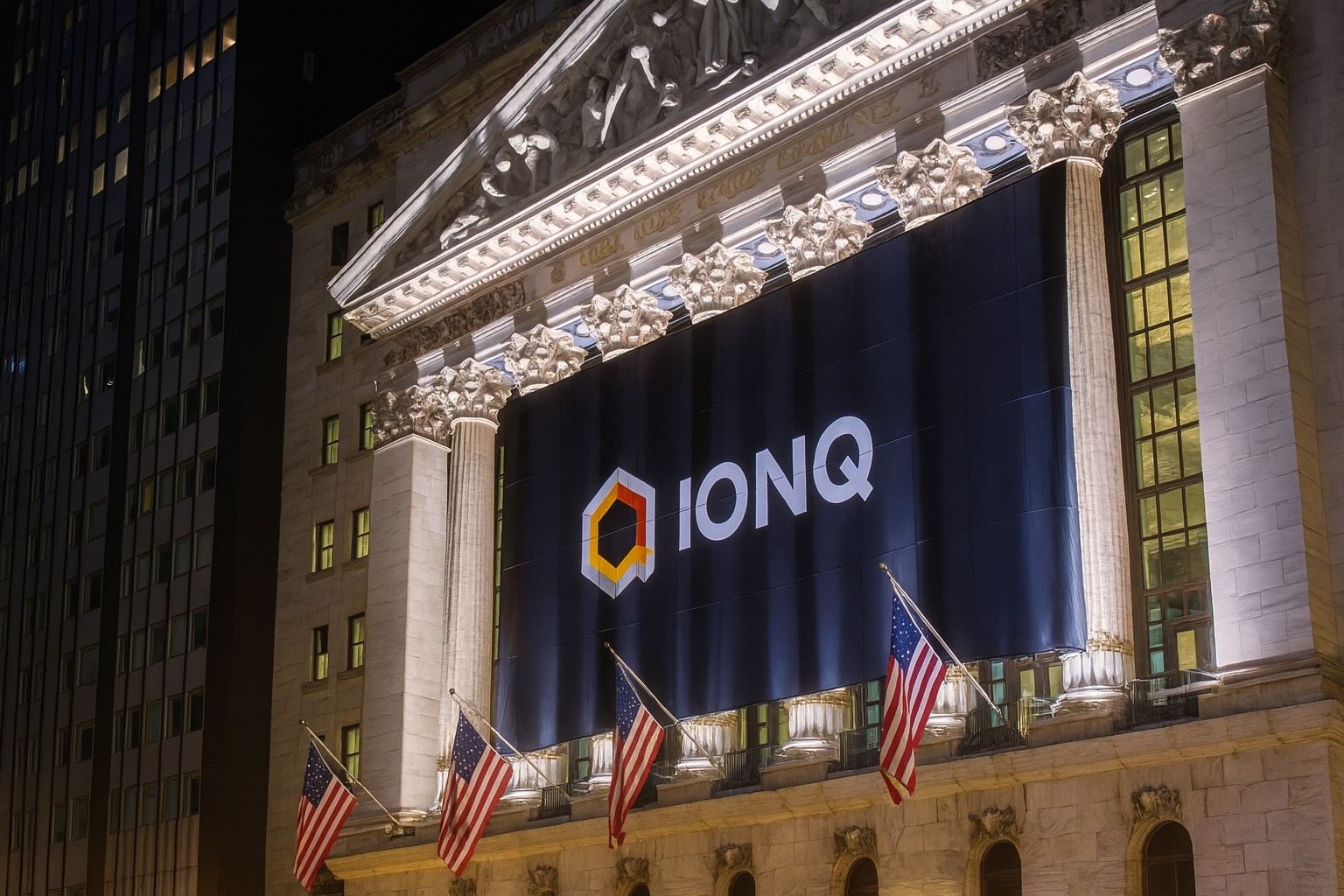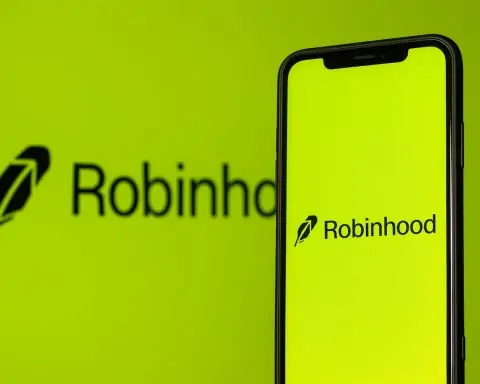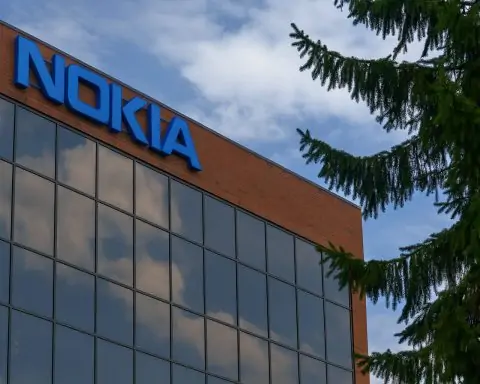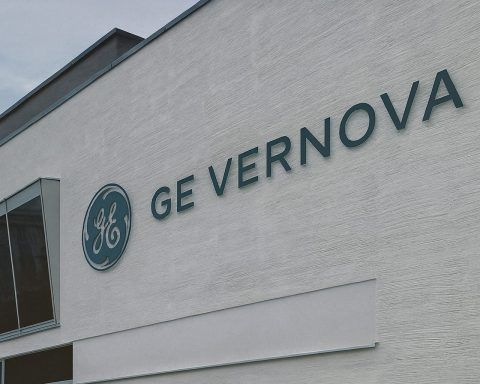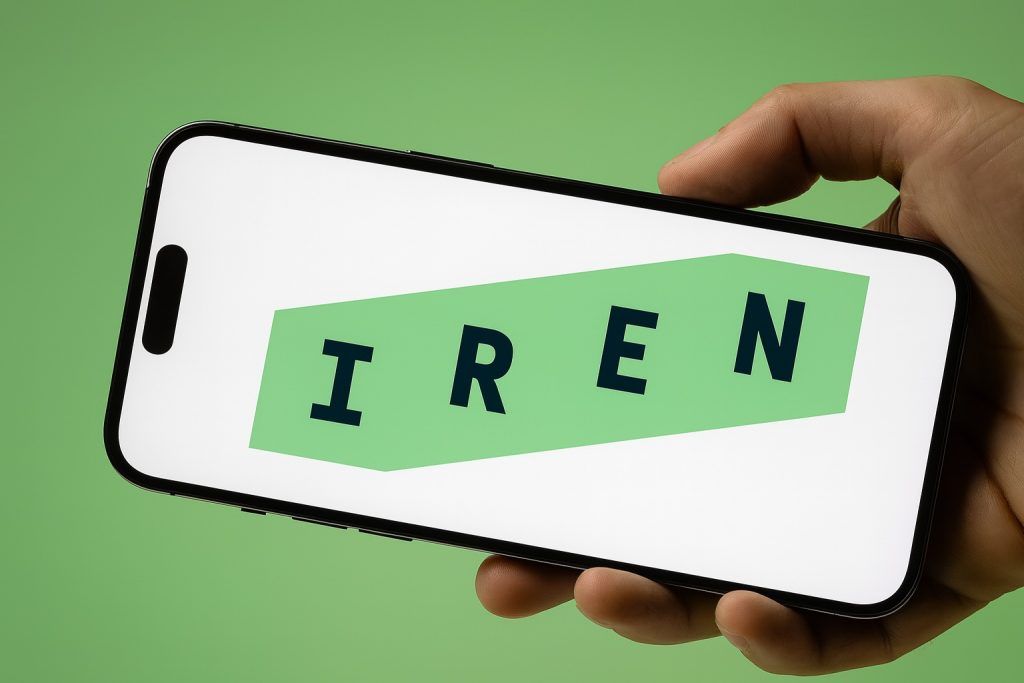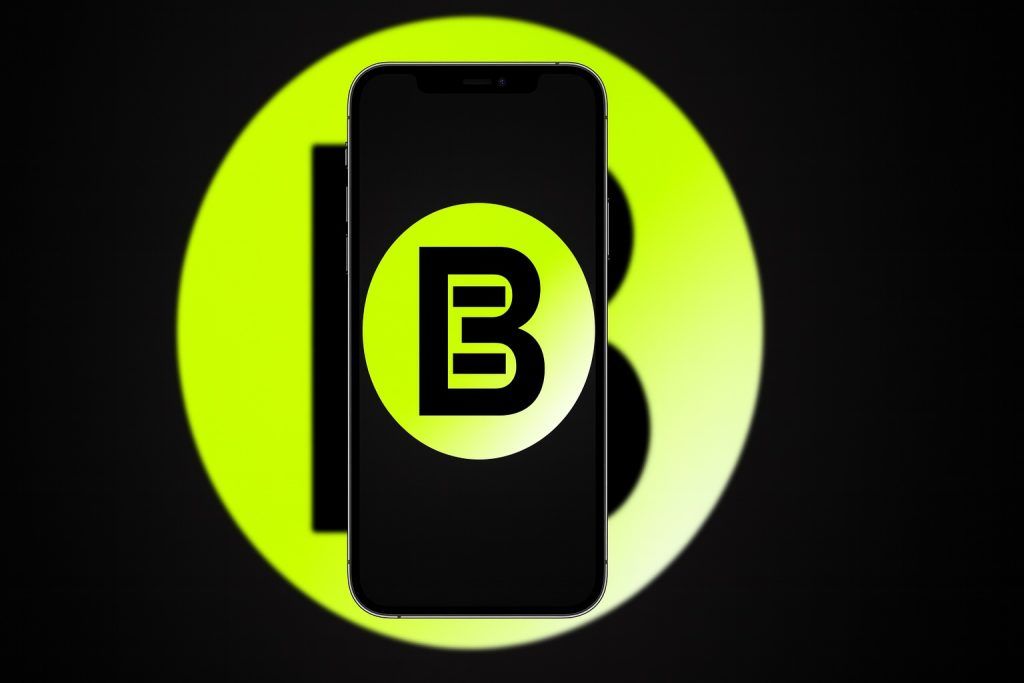- IonQ’s stock soars on quantum hype: Shares of IonQ (NYSE: IONQ) have skyrocketed in 2025, recently hitting an all-time high around $75 per share in early October – up roughly 70–75% year-to-date and over 700% year-on-year [1]. This surge vaulted IonQ’s market capitalization to about $20–22 billion [2], reflecting intense investor enthusiasm for quantum computing despite the company’s still-nascent revenues.
- Rapid growth but big losses: IonQ’s revenue is growing triple-digits yet remains modest relative to its lofty valuation. In Q2 2025 the company reported $20.7 million in revenue (up 82% YoY) – beating its guidance by ~15% [3]. On strong results, IonQ raised its full-year 2025 revenue forecast to $82–$100 million (from just $11M in 2022) [4]. However, heavy R&D spending and one-time charges led to a net loss of $177.5 million in Q2 [5]. IonQ took advantage of its soaring stock to raise $1 billion in new capital, ending Q2 with $1.6B cash on hand to fund growth [6].
- Major 2025 milestones: IonQ has aggressively expanded its capabilities via acquisitions and partnerships. It announced a $1.08 billion acquisition of UK-based Oxford Ionics to integrate “ion-trap-on-a-chip” tech – aiming for 800 logical qubits by 2027 and 80,000 by 2030 [7] [8]. IonQ also bought startups Lightsynq and Capella to advance photonic interconnects and quantum networking [9]. Even Amazon invested $36.7M in IonQ, underscoring rising big-tech interest [10]. Meanwhile, IonQ struck MOUs with research institutes (e.g. KISTI in South Korea, AIST in Japan) to collaborate on quantum R&D [11].
- Breakthrough tech achievements: In 2025 IonQ notched technical breakthroughs that excited the industry. It achieved a 20× speed-up in a drug discovery simulation by pairing its quantum processors with NVIDIA GPUs on the cloud [12]. IonQ also converted trapped-ion qubit emissions to telecom-band photons for the first time [13] – a quantum networking feat that could allow its quantum computers to communicate over standard fiber cables, “paving the way for a future ‘Quantum Internet’” [14]. These advances suggest real potential for quantum computing in pharma, logistics, and beyond.
- Recent news fuels rally: In early October, IonQ’s momentum got another jolt from fresh deals and sector buzz. The company revealed a strategic investment in Einride, a Swedish autonomous trucking startup, to apply quantum optimizations to freight logistics [15]. News that IonQ joined Einride’s $100M funding round sent IonQ’s stock jumping ~10% in one day [16] [17]. Adding to the optimism, IonQ’s photon-to-fiber breakthrough (enabling quantum machines to network) hit headlines at the same time [18]. Analysts responded with bullish commentary – for example, Needham hiked its price target to $80 (a Street-high) after IonQ’s recent Analyst Day, applauding the company’s “aggressive technology roadmap” [19].
- IonQ leads a quantum stock frenzy: IonQ is often compared to rival quantum pure-plays Rigetti and D-Wave, whose shares have also exploded in 2024–25. IonQ’s ~$20B valuation now doubles that of either competitor [20], and its Q2 revenue ($20.7M) far outstrips Rigetti’s ($1.8M) or D-Wave’s ($3.1M) [21]. All three remain unprofitable, but each touts recent milestones – from Rigetti’s record 99.5% qubit fidelities to D-Wave’s new 5,000-qubit annealer [22] [23]. The broader quantum computing sector is booming on speculation: consulting firm McKinsey projects the market could grow from ~$1B in 2025 to $72B by 2035 [24]. Yet experts caution this rally is “highly speculative” – current valuations far outpace fundamentals and volatility is extreme [25] [26]. Investors are betting on a future quantum revolution that is still several years away.
Stock Performance & Financial Overview
IonQ has been one of 2025’s standout stocks. The share price has skyrocketed this year, vastly outperforming the broader market. As of early October, IonQ trades near $73–$75 per share, around its record high [27], after climbing about 70% year-to-date and an astonishing 700%+ vs. a year ago [28]. For context, IonQ was valued near $2B in late 2022; its ~10× stock increase since then reflects dramatically shifted sentiment in favor of quantum computing plays [29]. At a $20+ billion market cap, IonQ is valued on par with some mid-cap tech firms – remarkable for a company that only did about $10–$11M in revenue a couple of years ago [30]. This euphoric valuation implies investors are looking well beyond current earnings, essentially treating IonQ as a high-upside bet on the future of computing.
Financially, IonQ is showing rapid growth (albeit from a small base) paired with heavy spending. In Q2 2025, IonQ delivered $20.7 million in revenue, an 82% jump year-over-year, and up 172% sequentially from Q1 [31]. This handily beat the company’s own guidance and indicated accelerating demand, as more customers access IonQ’s quantum systems via cloud platforms and partnerships [32]. Buoyed by the strong Q2, management raised full-year 2025 revenue guidance to $82–$100 million (from an initial $76–$84M) [33] – implying roughly triple the 2024 revenue level. However, IonQ’s rapid expansion comes at a steep cost. The company remains deeply in the red, as it pours money into R&D, talent, and acquisitions. Q2 2025 operating expenses swelled to $181M, resulting in a net loss of $177.5M for the quarter [34] [35]. (This was exacerbated by some non-cash charges like warrant liabilities, but even on an adjusted basis IonQ is far from breakeven.) The operating loss more than doubled from a year earlier [36], underscoring how aggressively IonQ is investing to advance its technology.
Notably, IonQ has fortified its balance sheet to sustain these losses. Riding high on investor optimism, the company executed a large secondary stock offering in mid-2025, raising over $1 billion in fresh equity capital [37]. This windfall boosted IonQ’s cash reserves to roughly $1.6 billion as of mid-year 2025 [38] – giving it one of the strongest cash positions in the sector. Management said this capital provides “substantial” funding for future R&D and strategic deals [39]. In effect, IonQ has used its soaring stock as a currency to ensure it can survive and spend for years ahead. Despite trading at an eye-popping ~200× forward sales multiple (even assuming $100M revenue this year) [40], IonQ’s advocates argue the money raised now could help it maintain a first-mover advantage in quantum computing’s long game.
Major Recent News & Events (Early October 2025)
IonQ’s stock rally has been freshly fueled by news over the past several days, as both company-specific developments and broader sector momentum electrified investors. One headline-grabbing event was IonQ’s move into autonomous vehicles: in late September, IonQ was revealed as a strategic investor in Einride, a Swedish startup focused on self-driving electric trucks. Einride announced on Oct 1 that it raised ~$100 million from backers including IonQ [41] to accelerate deployment of its autonomous freight systems. The partnership foreshadows IonQ applying its quantum algorithms to optimize complex logistics and routing problems in trucking. The market reacted with gusto – when news of IonQ’s Einride investment broke, IonQ’s stock surged over 10% in a day [42] [43]. Traders viewed it as a validation that IonQ’s quantum tech could have real-world impact beyond the lab. “This move signaled IonQ’s plan to apply its quantum computing to solve complex logistics problems,” noted one analysis, and it clearly struck a chord with investors [44] [45]. By the next afternoon session, IonQ shares were still ticking up (about +1%), riding “continued positive momentum” from the Einride deal [46].
Almost simultaneously, IonQ announced a breakthrough in quantum networking that further stoked excitement. The company revealed it can convert the photons emitted by its trapped-ion qubits into telecom-band (infrared) photons [47]. In practical terms, this means IonQ’s quantum computers could potentially communicate over today’s standard fiber-optic infrastructure, since telecom wavelengths travel long distances with low loss. As one tech outlet put it, this “breakthrough could allow [IonQ’s] quantum computers to communicate over existing fiber networks, paving the way for a future ‘Quantum Internet’” [48]. Such capability is crucial for eventually networking quantum processors together or linking users to quantum clouds with minimal signal loss. The announcement of this advance – a result of IonQ’s research in photonics – added to the buzz that next-gen quantum technologies are rapidly progressing. It also complemented IonQ’s acquisition of photonics firms (discussed below) aimed at enabling distributed quantum computing. In the stock market, the photon-news helped bolster the narrative that IonQ is at the forefront of not just building quantum computers, but also the quantum communication methods that could unleash their power on a wider scale.
It wasn’t just IonQ’s own news moving the stock – a wave of sector-wide enthusiasm lifted all quantum computing names in early October. In late September, competitor D-Wave made headlines by demonstrating a real-world use case: its annealing-based quantum system helped a UK police department slash certain emergency response times by nearly 50% (solving an optimization in minutes that took classical methods months) [49] [50]. The striking “four months to four minutes” result [51], announced Sept 30, was hailed as “real-world validation” of quantum tech [52] and garnered media fanfare. Around the same time (Oct 2), rival Rigetti announced a multi-million-dollar sale of two small quantum processors to a research customer, marking one of the industry’s first hardware sales [53]. These positive developments triggered a “sympathy rally” across quantum stocks [54]. On Oct 2, Rigetti’s stock jumped over 18% in a day, and IonQ’s shares climbed roughly 10% as well amid the broader momentum [55]. Investors piled into the sector on the perception that “quantum’s moment” had arrived, with tangible progress and deals finally materializing after years of hype [56] [57]. By the first week of October, quantum computing had turned into a mini gold rush on Wall Street – IonQ, as the largest and most liquid name in the space, naturally benefited from this rising tide.
Company Updates: Technology, Partnerships & Strategy in 2025
IonQ’s banner year 2025 has been marked not just by a stock surge, but by significant strategic moves and technological milestones. The company is executing a multi-pronged growth strategy to solidify its leadership in quantum computing. Key developments include:
- Bold Acquisitions: IonQ went on the offensive with M&A to accelerate its roadmap. In July, it announced a deal to acquire Oxford Ionics (a UK-based quantum startup) for $1.075 billion [58]. Oxford Ionics specializes in integrating trapped-ion qubits on microchips. By combining IonQ’s expertise in high-fidelity ion-trap processors with Oxford’s miniaturized “ion trap-on-chip” technology, IonQ aims to dramatically scale up future machines. The leadership projects this acquisition could enable “800 logical qubits in 2027 and 80,000 in 2030,” with error rates as low as 1 in 10 million [59] [60] – an almost unimaginable leap from today’s devices. “Together IonQ and Oxford Ionics have the team, IP, technology, and momentum to achieve 800 logical qubits in 2027 and 80,000 in 2030,” declared IonQ’s CEO Niccolo de Masi of the combined effort [61]. Such goals, while aspirational, underscore IonQ’s willingness to bet big on the future of error-corrected quantum computers. Alongside this mega-deal, IonQ completed two smaller tuck-in acquisitions in Q2: it bought Lightsynq (which provides photonic interconnects and quantum memory tech) and Capella (a startup working on satellite-based quantum communications) [62]. These moves support IonQ’s push beyond standalone quantum processors toward a networked “quantum internet” vision, where quantum computers link together via light – potentially even via satellites for long distances [63]. IonQ didn’t stop there: in September 2025 it also agreed to acquire Vector Atomic, a company developing quantum precision sensors (like atomic clocks and gyroscopes). This deal, for an undisclosed sum, brings IonQ over $200 million in existing government contracts held by Vector Atomic [64] [65] and expands IonQ into the quantum sensing arena. The Vector Atomic buy accelerates IonQ’s entry into quantum inertial sensors and positioning systems (important for defense and aerospace) and complements its computing portfolio. All told, IonQ’s acquisitions in 2025 have significantly broadened its IP and talent base – and signal an ambition to own every piece of the quantum tech stack, from computing to networking to sensing.
- Partnerships & Strategic Investments: IonQ has attracted high-profile partners and backers this year, highlighting growing confidence in its technology. Most notably, Amazon disclosed a $36.7 million equity stake in IonQ [66]. Amazon’s AWS cloud already hosts IonQ’s quantum systems (through the Amazon Braket service), so this investment deepens the tie – a sign that Amazon wants to share in IonQ’s upside (Amazon has made similar bets on other quantum firms like PsiQuantum). IonQ also inked new international partnerships: it signed Memoranda of Understanding with KISTI in South Korea and AIST in Japan – major national R&D institutes – to collaborate on quantum computing research and build regional quantum capabilities [67] [68]. These MOUs expand IonQ’s global footprint and could lead to future joint projects or sales in Asia. In the public sector, IonQ scored a prestigious government win: the U.S. Department of Energy selected IonQ for its “Quantum-In-Space” program [69]. This initiative will explore using quantum tech in orbit (e.g. satellite-based quantum communication or sensing). Being chosen by DOE (with NASA involvement) is both a credibility boost and an opportunity for IonQ to receive funding and access unique resources for space-based quantum experiments. It underscores how government agencies view IonQ as a key player – and quantum tech as strategically important. On the commercial side, IonQ is also pursuing real-world applications through strategic investments. As mentioned, IonQ took a stake in Einride to tackle quantum logistics optimization problems [70]. Rather than just a financial play, this partnership is expected to let IonQ develop and eventually deploy quantum algorithms for routing fleets of autonomous trucks – a complex optimization task that could showcase quantum advantages in supply chains. Through such deals, IonQ is not only expanding its technology, but also seeding future demand for its quantum services by helping industry leaders experiment with quantum solutions.
- Commercial Progress & Contracts: Crucially, IonQ has begun converting its tech prowess into paying contracts, providing early validation of its business model. A standout example came in Q2 2025 when IonQ secured a $22 million deal with EPB, a forward-thinking electric utility in Tennessee (USA) [71]. EPB, known for operating a cutting-edge fiber-optic smart grid, contracted IonQ to develop quantum computing solutions – likely aiming at problems like optimizing energy distribution or telecommunications networks. The multi-year contract, one of the largest publicly announced quantum commercial deals to date, helped drive IonQ’s Q2 revenue beat [72]. It shows that some enterprise customers are already willing to spend eight figures on quantum capabilities, even if today’s systems are still early-stage. Similarly, IonQ has ongoing projects with government and academia (often funded): for instance, working with Oak Ridge National Lab on power grid optimization and with University of Washington on quantum simulations for cosmology [73]. These collaborations not only bring in revenue or grants, but also help IonQ refine practical algorithms in partnership with domain experts. Furthermore, IonQ continues to offer its quantum computers via major cloud platforms (Amazon AWS, Microsoft Azure, Google Cloud), making it easy for companies and researchers to experiment on a pay-per-use basis. This “quantum cloud” access model means IonQ can monetize its machines without needing to build each client their own hardware. As usage grows, it could turn into a steady revenue stream – and it lowers barriers for new customers to try quantum computing. Overall, while still modest, IonQ’s commercial traction is growing: the company’s backlog and forward visibility improved in 2025, and its sales pipeline spans sectors from finance to pharma. Each real-world success (like the EPB project) is a proof-point to attract the next customer.
- Technical Breakthroughs: On the R&D front, IonQ’s scientists hit several milestones in 2025 that cement the company’s reputation for technical leadership. One headline achievement, as noted, was successfully converting trapped-ion qubit emissions to telecom-band photons [74]. In plain language, IonQ found a way for the UV/visible photons emitted by its ion qubits to be “translated” into infrared light that can travel long distances through fiber-optic cables [75] [76]. This is crucial because normally the photons from ion qubits are unsuitable for fiber transmission (they get absorbed quickly). By shifting them to the standard telecom wavelength, IonQ made a big stride toward enabling its quantum computers to be networked over existing infrastructure. As one report noted, this breakthrough shows IonQ’s tech could eventually “communicate over existing fiber networks,” paving the way for a future quantum internet [77] [78]. That long-term vision – linking quantum processors into distributed systems – is something IonQ is actively pursuing (bolstered by its Lightsynq/Capella acquisitions and the DOE space project). Another notable feat: IonQ demonstrated quantum’s promise in high-value industrial applications. In a collaboration with AstraZeneca, NVIDIA, and AWS, IonQ showed that a hybrid quantum-classical approach could accelerate a drug discovery simulation by 20× compared to classical computing alone [79]. By using IonQ’s quantum hardware alongside powerful GPUs to model molecular interactions, the team was able to speed up a chemistry calculation relevant to pharmaceutical design [80]. While this was a proof-of-concept, it hints that quantum advantage in certain chemistry and materials problems might be on the horizon as hardware improves. IonQ is also exploring quantum machine learning and optimization use-cases through various partnerships. Importantly, the company continues to push the envelope on its core hardware performance – its latest systems (like IonQ Forte) offer among the highest qubit fidelity in the industry, meaning IonQ’s qubits maintain quantum coherence and accuracy better than most competitors [81] [82]. High fidelities allow running deeper circuits (more calculations before errors overwhelm), which is a key metric for usefulness. IonQ frequently touts its record Quantum Volume scores (a holistic performance benchmark); e.g., IonQ Harmony achieved a quantum volume of 2.6 million, far above many peers [83]. In summary, IonQ’s R&D momentum in 2025 – from networking and algorithms to improved qubit stability – strengthens its position as a technology leader in quantum computing.
- Leadership & Talent: IonQ has also seen some leadership updates and notable hires this year, aimed at scaling the company for growth. In early 2025, CEO Peter Chapman (who led IonQ since 2019) transitioned to an Executive Chairman role, and Niccolo de Masi – a tech executive who was instrumental in taking IonQ public via SPAC – became Chairman of the Board [84]. This shift added high-level oversight as IonQ navigates its hyper-growth phase. Day-to-day, Chapman’s move freed him to focus on long-term strategy and technology vision, while new senior leaders have been brought in to handle operations. IonQ is also beefing up its bench with top-tier talent from relevant fields. For example, it hired Dr. Marco Pistoia, the former head of JPMorgan’s Quantum Research team, bringing expertise in quantum algorithms for finance [85]. It also added Dr. Rick Muller, previously a director at IARPA (the U.S. intelligence community’s advanced research arm) [86]. Both hires bring valuable domain knowledge – Pistoia in applying quantum to financial use-cases, and Muller in navigating government research programs. Attracting such experts from banking and defense circles is a strong signal of IonQ’s growing stature and its intent to be a magnet for quantum talent. The company’s headcount in quantum engineering and software has swelled, and it continues to collaborate with universities to recruit the next generation of quantum scientists. In an industry where skilled researchers are in short supply, IonQ’s ability to lure high-profile names bodes well for its innovation capacity. As Deloitte noted, the quantum workforce is still small but rapidly evolving [87] – and IonQ appears to be winning minds in the field.
In sum, 2025 has been a transformative year for IonQ on multiple fronts. The company solidified its financial footing (via capital raises) and expanded its product roadmap through acquisitions, all while notching technical achievements and real customer wins that bolster its credibility. Each puzzle piece – from the Oxford Ionics deal to the DOE project to the EPB contract – fits into IonQ’s grand plan of becoming the dominant full-stack quantum computing platform. These moves have also widened the gap between IonQ and smaller rivals in terms of resources and momentum. However, execution will be key: IonQ has set very bold targets, and the coming years will test whether it can deliver on its promises and maintain its lead as the quantum race accelerates.
Market Analysis & Analyst Outlook
IonQ’s spectacular rise has drawn intense interest from analysts and investors trying to gauge what comes next. On Wall Street, sentiment has turned bullish but remains split between excitement and caution. Following IonQ’s late-September Analyst Day (where the company detailed its roadmap and recent advances), several analysts boosted their price targets for the stock. Notably, Needham & Co. maintained a “Buy” rating and raised its IonQ target from $60 to $80 – the highest on the Street – citing the company’s aggressive technology roadmap and rapid progress [88]. Cantor Fitzgerald also revised its target upward (specific new target not publicly disclosed), expressing increased confidence in IonQ’s long-term prospects [89]. Earlier in September, Benchmark Capital had similarly hiked its target to $75 (from $55) after IonQ announced major deals with the U.S. Department of Energy and the Vector Atomic acquisition [90] [91]. These bullish calls reflect a view that IonQ is capitalizing on its first-mover advantage and could continue to deliver outsized growth. As one analyst put it, IonQ’s ambitious roadmap – including plans for error-corrected quantum systems – positions it as a potential “IBM of quantum” in the coming decade if execution holds up [92] [93].
At the same time, many observers emphasize that IonQ’s valuation has far outpaced its current fundamentals – making the stock’s trajectory highly speculative. Even with ~$90M revenue at the midpoint of IonQ’s 2025 guidance, the stock trades at over 200× this year’s sales [94]. Such a multiple “assumes massive future growth” and years of successful innovation ahead [95]. “IonQ sports a market cap of approximately $12 billion…considering the company’s only revenues today come from early-stage quantum services,” one analyst remarked incredulously (when IonQ was still a $12B company) [96]. Indeed, much of IonQ’s market value is essentially an optimistic bet on its future – on it becoming one of the big winners as quantum computing matures. Analysts at Alpha Spread summarized the situation bluntly: “Pure-play quantum computing companies such as IonQ, D-Wave, and Rigetti are still in early development stages. Their revenues remain low, losses are large, and the technology is not yet ready for widespread real-world use.” [97]. The recent quantum stock rally, they noted, “has been fueled more by investor optimism, hype…and government support than by fundamentals.” [98]. In other words, current valuations “price in” years of future growth and breakthroughs that must still be realized [99]. Any delays or disappointments could trigger sharp pullbacks.
Most experts therefore urge caution alongside the excitement. Quantum computing is a long-term play, and volatility is the norm. IonQ’s stock has experienced over 100 days with ±5% swings in the past year [100] – an astonishing level of churn. On both the upside and downside, moves can be extreme. “Quantum stocks can be extraordinarily volatile… Companies might gain 30%, 50%, or even hundreds of percent in a day based on a research headline,” The Motley Fool quipped of the recent frenzy [101]. One need only look at 2025 trading: IonQ popped 10%+ on the Einride news; in earlier periods, it also fell 20%+ on broader market jitters. Traders are essentially trying to handicap scientific progress and adoption timelines, which is challenging. If IonQ or a peer announces a leap in qubit count or a big contract win, stocks can spike overnight. Conversely, a rumor of a delay or a dilution (new share offering) can send them plunging. As a result, some analysts warn that IonQ (and its peers) “may be more speculative bets rather than stable long-term investments at this stage.” [102] Financial advisors suggest that only risk-tolerant investors with a multi-year horizon should consider significant positions in these names, and even then, position sizing is crucial.
Looking further out, market forecasts for quantum computing are undeniably bullish, which underpins the optimism in IonQ. Multiple research firms predict an exponential growth trajectory for the sector as the technology matures. For example, McKinsey estimates the quantum computing market could grow from around $4 billion in 2024 to between $28–$72 billion annually by 2035 [103] [104] (depending on how quickly practical quantum advantage is achieved). Some forecasts that include adjacent quantum areas (like quantum communication and sensing) see over $100 billion in total quantum tech revenues by 2035 [105], and over $1 trillion in economic value by then when considering indirect impacts [106]. Even nearer term, the industry is expected to cross $1B in annual revenue in 2025 [107] – a symbolic but important milestone indicating that quantum is moving from lab research into early commercialization. If IonQ can capture a significant share of this expanding pie, its current valuation could be justified or even have room to grow. Wall Street analysts, in issuing lofty price targets, are essentially saying they believe IonQ will execute well and remain a leader as quantum computing starts creating real value.
In summary, the investment thesis for IonQ is a high-risk, high-reward proposition. The company’s strengths – technological excellence, ample cash, and growing industry traction – make it a frontrunner in a field with enormous potential. Bulls argue that IonQ could ride a “winner-takes-most” dynamic if it delivers the first truly scalable quantum computers, leading to outsized financial rewards (through cloud services, IP licensing, or even being an acquisition target for a tech giant). Bears counter that the timeline to meaningful profits is still very uncertain, and that IonQ (like others) might face setbacks as engineering challenges mount. In the near term, expect volatility: as IonQ hits or misses interim milestones (qubit count goals, error rate improvements, customer wins), the stock will likely swing accordingly. The current consensus leans optimistic – e.g., Needham’s $80 target implies further upside – but also acknowledges that IonQ’s valuation already assumes a lot of success. For the general public investor, the IonQ story highlights both the thrilling promise and the substantial peril of investing in cutting-edge tech before it fully materializes.
Broader Industry Context & Competition
IonQ’s rise is occurring amid a broader quantum computing boom in 2024–2025, as investor interest in this once-esoteric sector has reached a fever pitch. The company is one of only a few publicly traded, pure-play quantum computing firms – the other notable ones being Rigetti Computing (NYSE: RGTI) and D-Wave Quantum (NYSE: QBTS). Each of these companies uses a different approach to quantum computing, and all have seen remarkable stock rallies over the past year (though IonQ is the largest by far). A quick look at IonQ’s peers:
- Rigetti Computing (RGTI) – Superconducting Qubits: Rigetti builds quantum processors using superconducting circuits (an approach similar to Google’s and IBM’s). After a rough 2022, Rigetti’s stock went on a jaw-dropping run in 2023–2025: it was a penny stock (~$1) and by October 2025 had surged to around $35–$40 per share (a 2,500%+ gain over 12 months) [108] [109]. This gives Rigetti roughly a $10–11 billion market cap [110]. The rally has been fueled by technical progress and deals – Rigetti recently demonstrated a multi-chip quantum processor (nicknamed “Cepheus”) with a 36-qubit system achieving 99.5% two-qubit gate fidelity [111], a new high for them, indicating improved accuracy. It has also secured government support, such as a $5.8M U.S. Air Force contract for quantum networking research [112]. In early October, Rigetti announced selling two small quantum computers to an overseas customer (reportedly universities in Australia) in a multi-million deal, which sent its stock up 18% in one day [113]. Rigetti’s technology is seen as promising (it’s pursuing scalable chip architectures with modular “chiplets”), but its revenues remain tiny – only $1.8M in Q2 2025 [114]. The company is burning cash and, like IonQ, is not expected to turn a profit for years. Still, investor sentiment for Rigetti has been optimistic on the back of its rebirth from penny-stock status; some view it as a potential fast-follower if IonQ falters. Rigetti’s CEO Subodh Kulkarni recently stated, “Our industry-leading chiplet approach to scaling and strong financial position makes us confident in hitting our end-of-year technology goals,” underscoring their determination to meet roadmap targets (and justify the hype) [115] [116].
- D-Wave Quantum (QBTS) – Quantum Annealing: D-Wave, based in Canada, takes a very different tack. It specializes in quantum annealers – machines designed for optimization problems (like scheduling, routing, minimizing costs) rather than general-purpose computing. D-Wave has the distinction of being the first company to sell a quantum computer (it’s been around for two decades), and over 200 million problems have been run on its systems by customers to date [117]. After years of being privately held, D-Wave went public via SPAC in 2022. Its stock spent 2022–23 largely languishing under $5, but caught fire in mid-2025. By October 2025, D-Wave’s shares had shot up to the mid-$30s – an increase of ~30-fold from a year prior (the stock was ~$1 in late 2024) [118] [119]. Year-to-date, it was up roughly +280% [120]. This parabolic rise was driven by a cascade of good news: besides the aforementioned UK police pilot where D-Wave’s quantum-hybrid solution cut emergency response planning time by ~85% [121] [122], the company launched its 6th-gen Advantage2 annealer in 2025 with over 5,000 qubits and 20× higher connectivity than before [123]. D-Wave claims this new machine has shown up to 500× speedups on certain benchmark problems versus classical methods [124]. It’s also pursuing an ambitious roadmap toward 100,000-qubit systems by 2030 [125]. Unlike IonQ and Rigetti, D-Wave actually has a small but notable revenue stream (~$3.1M in Q2 2025 [126]) from providing cloud access and consulting for businesses solving optimization tasks (e.g. Volkswagen and aerospace companies have experimented with D-Wave for logistics issues). Investors have been intrigued that D-Wave’s tech is already being used for practical applications, even if limited. However, annealing is a niche – it’s not universal quantum computing and cannot run algorithms like Shor’s or most quantum AI algorithms. So D-Wave’s long-term role is uncertain; it has begun exploring gate-model quantum computing in R&D to not get left behind [127]. For now, D-Wave’s stock has ridden the quantum hype but with some justification from real case studies. The company acknowledges that euphoria may have outrun fundamentals: Zacks recently rated it a Hold, noting D-Wave (like its peers) remains unprofitable and valued on future potential. Still, D-Wave’s CEO highlights that hundreds of early customer applications (in finance, manufacturing, etc.) are proof that “quantum solutions are being deployed now”, aiming to convince investors that this isn’t just theoretical.
IonQ vs Peers: IonQ’s position relative to Rigetti and D-Wave is one of market leadership – but also steeper expectations. With IonQ’s market cap near ~$20B, it is roughly the size of Rigetti + D-Wave combined [128] [129]. IonQ’s trapped-ion technology is different: it targets general-purpose, gate-based quantum computing with a focus on achieving long-term fault-tolerant qubits via error correction. This is a harder, longer-term problem than what D-Wave tackles, but potentially far more transformative if solved (since gate-model quantum computers can run the full range of quantum algorithms for chemistry, cryptography, etc.). In the near term, IonQ actually enjoys a revenue lead – its ~$20.7M in Q2 revenue was about 5–10× higher than Rigetti or D-Wave managed [130]. This is partly because IonQ can offer cloud access to its machines for a variety of use cases (similar to how IBM does), whereas Rigetti is just ramping up and D-Wave’s use-case is narrower. All three companies are unprofitable and likely will be for years, relying on investor capital and occasional government grants to sustain R&D. The trio’s stocks have been moving more on technological milestones and speculation than on financial results – a single breakthrough can send shares soaring, while any hint of missed targets can do the opposite. It’s worth noting that Rigetti and D-Wave’s rallies have been even more extreme in percentage terms than IonQ’s, simply because they started from such low bases (both were trading under $2 in 2023). Over the month leading into October 2025 alone, Rigetti’s stock jumped ~165%, D-Wave’s 116%, and IonQ’s ~79% [131] – astounding gains across the board. Some analysts have dubbed it a “quantum bubble”, warning that these moves aren’t fully supported by tangible progress and could reverse. In response, quantum executives (IonQ’s included) have tended to agree that while the excitement is welcome, the journey is just beginning and practical commercial impact is still a few years out.
Beyond this trio, the competitive landscape includes both Big Tech giants and well-funded startups. Tech titans like IBM, Google, Microsoft, and Amazon each have major quantum programs [132]. IBM, for instance, now offers 433-qubit superconducting processors on its IBM Quantum cloud, and is developing a 1,121-qubit chip (“Condor”) slated for 2025 [133]. IBM has over 200 clients experimenting on its quantum systems (often via cloud), and its yearly Quantum Summit updates are industry events. Google famously achieved “quantum supremacy” in 2019 on a specialized task, and in 2023 demonstrated elements of quantum error correction; Google’s focus is on research breakthroughs and it hasn’t commercialized its superconducting qubit machines yet [134] [135]. Microsoft has a unique approach – it’s betting on theoretical topological qubits (which could be more stable if they ever work), but after years of effort it has yet to produce a working qubit of that kind [136] [137]. In the meantime, Microsoft acts as a quantum cloud integrator: its Azure Quantum service hosts hardware from IonQ, Rigetti, and others, essentially making Microsoft a distribution partner for IonQ rather than a direct competitor currently [138]. Amazon, similarly, doesn’t publicize any homegrown quantum hardware yet, but through AWS Braket it offers cloud access to machines from IonQ, Rigetti, D-Wave, and a few others [139]. Amazon has opened a Center for Quantum Computing at Caltech to research superconducting qubits, indicating it’s quietly preparing its own tech down the road [140]. Notably, Amazon’s minor equity investments in companies like IonQ and Quera (neutral-atom quantum computers) show it’s hedging bets and seeking insight into multiple quantum modalities [141].
In the startup realm, Honeywell’s Quantinuum (formed by merging Honeywell’s quantum division with Cambridge Quantum) is often cited as IonQ’s closest private competitor. Like IonQ, Quantinuum uses trapped-ion hardware (derived from Honeywell’s designs) and has achieved high fidelities and mid-scale qubit counts (e.g. a 32-qubit machine) [142]. Quantinuum also has a strong software arm (it’s known for the TKET software stack and quantum chemistry algorithms). While not public, Quantinuum has the deep pockets of Honeywell and recently took on new investments (e.g. from Japanese firms), so it’s well-funded and aiming for similar goals (error-corrected qubits by ~2027) [143] [144]. Other notable startups include PsiQuantum (U.S.), which is pursuing a photonic quantum computer with a target of 1 million qubits using silicon photonics. PsiQuantum has raised around $600M and is working with global chip foundries, aiming for a commercial-grade photonic quantum system later this decade [145]. There’s also Xanadu (Canada), another photonics-focused company that developed the PennyLane software library and achieved a 216-mode photonic processor for boson sampling tasks [146]. In Europe, Pasqal (France, using neutral atoms) and IQM (Finland/Germany, superconducting) are emerging players, each backed by government initiatives. And in Asia, China’s tech giants (like Alibaba, Baidu, Huawei) and top universities (like USTC) have quantum programs that have reported impressive one-off results (e.g. photonic “quantum advantage” demonstrations) [147] [148]. This global web of efforts means IonQ cannot be complacent – innovation is coming from all corners, and while IonQ is ahead in the public markets, the race for quantum supremacy is far from settled.
Broad industry trends in 2025 reflect a field moving from pure research toward early commercial exploration. There’s a surge in funding: roughly $2 billion in venture and public funding flowed into quantum tech startups in 2024 alone, up 50% from the prior year [149]. Governments are a big part of this, investing in national quantum programs and even directly in companies (in 2024, ~$680M of global quantum startup funding came from government sources [150]). This is driven by the strategic importance of quantum – nations see leadership in quantum tech as a geopolitical priority (for encryption/security, economic advantage, etc.). Another trend is the push for hybrid computing: since today’s quantum processors are limited, there’s emphasis on combining them with classical supercomputers to tackle problems together [151]. Many breakthroughs, like IonQ’s 20× drug discovery speedup, are hybrid achievements where quantum handles a part of the task and classical computing does the rest [152] [153]. This will likely be the norm for the next several years. Additionally, we see work on quantum software, algorithms, and developer tools expanding the ecosystem [154]. Companies like Zapata and QC Ware focus on software that optimizes how algorithms run on quantum hardware. Open-source frameworks (IBM’s Qiskit, Google’s Cirq, etc.) are maturing, and universities are beginning to include quantum computing in curricula, slowly addressing the quantum talent gap (though demand still far exceeds supply of trained quantum engineers) [155]. There’s also movement towards standardizing benchmarks and metrics – e.g., IBM’s Quantum Volume has become one way to compare overall performance of quantum systems, and consortia are working on cross-industry standards [156]. This helps cut through hype by providing hard numbers (like error rates, coherent operation counts, etc.) for each new machine.
Despite all the excitement, the industry is candid about the challenges and unknowns ahead. The biggest technical hurdle remains achieving scalability with error correction – essentially building quantum processors that can correct their own mistakes and reliably run long calculations. Estimates for when this will happen vary widely: some optimists say ~5 years, others 10–15 years or more [157] [158]. IonQ’s target of 800 logical qubits by 2027 is extremely aggressive and not guaranteed. It’s possible progress will stall or hit diminishing returns; for example, simply adding more physical qubits could make errors grow faster than error-correction can handle [159]. There’s also the risk of new contenders or technologies disrupting current leaders – maybe a breakthrough in photonics or a totally new qubit design could leapfrog IonQ’s trapped ions. Or a well-funded effort in China or at Google could achieve a milestone that suddenly makes the market question IonQ’s approach. Furthermore, on the market adoption side, many potential customers are in a wait-and-see mode. Large companies may experiment with quantum pilots (as JPMorgan, BMW, Airbus and others have done), but they won’t deploy real budget dollars until quantum computers clearly outperform classical solutions for their use cases. This could result in a slower revenue ramp industry-wide than stock prices currently imply, at least in the next few years. Some analysts mention the Gartner “hype cycle”: quantum computing might be near the “Peak of Inflated Expectations” now, and could face a “Trough of Disillusionment” if breakthroughs take longer than hoped [160]. In practical terms, that means these stocks could seesaw – huge run-ups followed by sharp corrections – as reality catches up with hype.
For now, IonQ sits at the forefront of this nascent industry, carrying both the hopes of quantum’s potential and the skepticism of seasoned tech investors. Its 2025 performance encapsulates the narrative: extraordinary stock gains, incredible technological promises, and the first glimmers of commercial value, contrasted against massive losses and the admission that true payoff is still on the horizon. The next 12–24 months will be critical in determining if IonQ and its peers can maintain momentum. Investors will be watching for concrete proof of progress: Does IonQ close the Oxford Ionics acquisition smoothly and start integrating those chips? Will it announce a new quantum processor with significantly higher qubit count or lower error rates? Are more paying customers (beyond research collaborations) signing on? Any signs that quantum computing is moving from experiment toward indispensable tool will bolster the bull case. Conversely, if technical progress slows or if macro conditions (like higher interest rates) make speculative stocks less attractive, IonQ’s share price could retrace.
Big picture: Quantum computing is often likened to the early days of aviation or spaceflight – high risk, high reward. Companies like IonQ are effectively attempting to rewrite the rules of computing by harnessing quantum physics. If they succeed, the impact on industries from cryptography (breaking certain encryptions) to medicine (simulating molecules) to AI (exponentially faster training) could be revolutionary – a multi-trillion-dollar shift over decades. If they fall short or even just significantly delay, current valuations will look folly. As of October 2025, IonQ stands as a flag-bearer of the quantum revolution, its soaring stock a reflection of both investor optimism and the huge uncertainty inherent in unproven technology. The company’s next steps – and its ability to execute on bold promises – will be eagerly watched by technologists, businesses, and public investors alike. In the meantime, IonQ’s journey is a case study in the balance of hype vs. hope in cutting-edge tech: an inspiring vision of the future tempered by the hard realities of science and engineering that must be overcome to get there.
Sources:
- Marcin Frąckiewicz, “IonQ’s 2025 Quantum Leap: Surging Stock, Bold Ambitions & How It Compares to Rigetti and D-Wave,” Tech Space 2.0 (ts2.tech) – Oct. 4, 2025 [161] [162].
- Marcin Frąckiewicz, “Quantum Gold Rush: D-Wave (QBTS) Skyrockets on Breakthroughs as Quantum Computing Frenzy Heats Up,” Tech Space 2.0 – Oct. 4, 2025 [163] [164].
- “Quantum Rocket or Bubble? RGTI’s Stunning Surge Explained — And How It Stacks Up to IonQ, D‑Wave, and QUBT,” Tech Space 2.0 – Oct. 4, 2025 [165] [166].
- “Quantum Computing Stocks Set to Soar: 2025’s Next Tech Investment Boom,” Tech Space 2.0 – Oct. 5, 2025 [167] [168].
- Petr Huřťák, “Why IonQ (IONQ) Stock Is Up Today,” StockStory/TradingView News – Oct. 3, 2025 [169] [170].
- Zaheer Kachwala, “Self-driving truck company Einride raises $100 million,” Reuters – Oct. 1, 2025 [171].
- “IonQ (IONQ) Shares Skyrocket, What You Need To Know,” StockStory via WaterWorld/FinancialContent – Sept. 18, 2025 [172] [173].
- “Quantum Computing News: 2–5 October 2025 (Roundup),” Tech Space 2.0 – Oct. 5, 2025 [174] [175].
- Additional sources: Company press releases, Yahoo Finance, and McKinsey Quantum reports as cited in the above references [176] [177].
References
1. ts2.tech, 2. ts2.tech, 3. ts2.tech, 4. ts2.tech, 5. ts2.tech, 6. ts2.tech, 7. ts2.tech, 8. ts2.tech, 9. ts2.tech, 10. ts2.tech, 11. ts2.tech, 12. ts2.tech, 13. ts2.tech, 14. www.tradingview.com, 15. www.tradingview.com, 16. www.tradingview.com, 17. www.reuters.com, 18. www.tradingview.com, 19. markets.financialcontent.com, 20. ts2.tech, 21. ts2.tech, 22. ts2.tech, 23. ts2.tech, 24. ts2.tech, 25. ts2.tech, 26. ts2.tech, 27. ts2.tech, 28. ts2.tech, 29. ts2.tech, 30. ts2.tech, 31. ts2.tech, 32. ts2.tech, 33. ts2.tech, 34. ts2.tech, 35. ts2.tech, 36. ts2.tech, 37. ts2.tech, 38. ts2.tech, 39. ts2.tech, 40. ts2.tech, 41. www.reuters.com, 42. www.tradingview.com, 43. stockstory.org, 44. stockstory.org, 45. stockstory.org, 46. stockstory.org, 47. www.tradingview.com, 48. www.tradingview.com, 49. ts2.tech, 50. ts2.tech, 51. ts2.tech, 52. ts2.tech, 53. ts2.tech, 54. ts2.tech, 55. ts2.tech, 56. ts2.tech, 57. ts2.tech, 58. ts2.tech, 59. ts2.tech, 60. ts2.tech, 61. ts2.tech, 62. ts2.tech, 63. ts2.tech, 64. markets.financialcontent.com, 65. markets.financialcontent.com, 66. ts2.tech, 67. ts2.tech, 68. ts2.tech, 69. ts2.tech, 70. ts2.tech, 71. ts2.tech, 72. ts2.tech, 73. ts2.tech, 74. ts2.tech, 75. ts2.tech, 76. ts2.tech, 77. ts2.tech, 78. ts2.tech, 79. ts2.tech, 80. ts2.tech, 81. ts2.tech, 82. ts2.tech, 83. ts2.tech, 84. ts2.tech, 85. ts2.tech, 86. ts2.tech, 87. ts2.tech, 88. markets.financialcontent.com, 89. markets.financialcontent.com, 90. markets.financialcontent.com, 91. markets.financialcontent.com, 92. ts2.tech, 93. ts2.tech, 94. ts2.tech, 95. ts2.tech, 96. ts2.tech, 97. ts2.tech, 98. ts2.tech, 99. ts2.tech, 100. ts2.tech, 101. ts2.tech, 102. ts2.tech, 103. ts2.tech, 104. ts2.tech, 105. ts2.tech, 106. ts2.tech, 107. ts2.tech, 108. ts2.tech, 109. markets.financialcontent.com, 110. ts2.tech, 111. ts2.tech, 112. ts2.tech, 113. ts2.tech, 114. ts2.tech, 115. ts2.tech, 116. ts2.tech, 117. ts2.tech, 118. ts2.tech, 119. ts2.tech, 120. ts2.tech, 121. ts2.tech, 122. ts2.tech, 123. ts2.tech, 124. ts2.tech, 125. ts2.tech, 126. ts2.tech, 127. ts2.tech, 128. ts2.tech, 129. ts2.tech, 130. ts2.tech, 131. ts2.tech, 132. ts2.tech, 133. ts2.tech, 134. ts2.tech, 135. ts2.tech, 136. ts2.tech, 137. ts2.tech, 138. ts2.tech, 139. ts2.tech, 140. ts2.tech, 141. ts2.tech, 142. ts2.tech, 143. ts2.tech, 144. ts2.tech, 145. ts2.tech, 146. ts2.tech, 147. ts2.tech, 148. ts2.tech, 149. ts2.tech, 150. ts2.tech, 151. ts2.tech, 152. ts2.tech, 153. ts2.tech, 154. ts2.tech, 155. ts2.tech, 156. ts2.tech, 157. ts2.tech, 158. ts2.tech, 159. ts2.tech, 160. ts2.tech, 161. ts2.tech, 162. ts2.tech, 163. ts2.tech, 164. ts2.tech, 165. ts2.tech, 166. ts2.tech, 167. ts2.tech, 168. ts2.tech, 169. www.tradingview.com, 170. www.tradingview.com, 171. www.reuters.com, 172. markets.financialcontent.com, 173. markets.financialcontent.com, 174. ts2.tech, 175. ts2.tech, 176. ts2.tech, 177. ts2.tech
